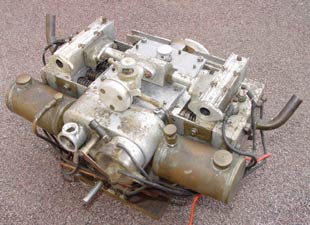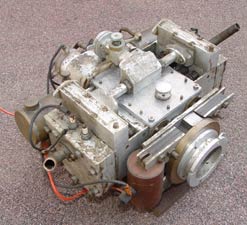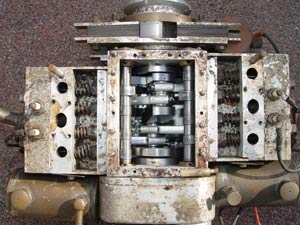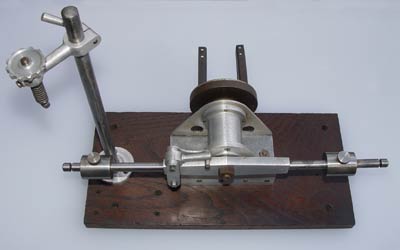

|
Home Updates Hydros Cars Engines Contacts Links Page 9 ←Previous Next→ Pit Box Index |
| Pit Box |
| Westbury Walrus | Westbury Dyno | Home built two stroke | Bungay 600 |
| Kapusikov | Speedwell | Mystery four stroke | Flash Steam |
| Stuart Turner AE twin | Flash Steam twin | Reversed Rossi | King McCoy |
 |
 |
 |
|
The 'Walrus' |
||
 |
Edgar Westbury's Dyno Not strictly a dynamometer, more of a torque reaction device. This was amongst the treasure trove of items discovered in his daughter's garage over forty years after his death. The motor to be tested was mounted on the bearers at the top and a spring or spring balance between the torque arm and the adjuster on the left. The lever on top of the arm stops the arm rotating. The only load on the motor is the propeller. The entire device was rusted solid when found and what is seen here the result of many dirty hours with emery cloth. OTW photo Nov 2015 |
|
|
Euan's 'mystery' The late Euan Forbes had this motor on his stall for several seasons without it finding a new home. It is home built and looks relatively old and given the angle of the exhaust and clutch saw service in a tethered car at some stage. The strangler on the venturi and size of the holes would indicate that it was not the most powerful motor around and one wonders if the cylinder head was from a much bigger engine or designed like this. At around 12cc it is no miniature either, but a mystery at present. OTW photo Oct 2015 |
|
|
Bungay (where you go to get a new bottom) So the saying goes, but that is Bungay in Suffolk, home and alma mater to the OTW team for many years until the move to 'the big city'. It is the name association only that provides the link to this motor built by the Bungay Brothers of New York from 1948. It is a big lump but 28,000 rpm 'free speed' was the claim advertised. The shaft induction with downward pointing venturi was out of step with most of its contemporary racing engines and made mounting in a car a challenge. There have been numerous replicas and motors built from parts over the years, varying from the absolute rubbish to the quite convincing, so buyer beware if one of these comes your way. This one was advertised as an original, but the brightness of machined surfaces gave several parties food for thought. OTW photo Sept 2015 |
|
|
Dominant motor For over 25 years two motors have been at the forefront of 1.5cc tethered car racing, the Kapu and AFA. In addition Kapu cars are still the number one choice for many. The AFA is the work of Boris Afanasiev, whilst the Kapu shown here was down to fellow Russsian, Alexsander Kapusikov. Between them they won 17 World and European championships from the late 80s onward. The death of Kapusikov four years ago left a huge void in the supply of cars, motors and spares for the 1.5cc class making them increasingly scarce and valuable. The last time we ever saw Kapusikov he was still running cars despite being swathed in bandages from a very serious operation. |
|
|
A little more Speedwell Back in 2012 we featured one of these very rare, yet attractive, British built motors. Only three of those built were known to exist, but now there is confirmation of a fourth. It is just how many that were built by Ken Robinson down in Kent that is in question. We were led to believe that the number was 12, yet the serial number on this example is 16. Number 8 is in Kent and it is hoped that between its owner and the two engines we might be able to put together a more detailed appreciation of this valiant attempt to produce a competitive British tethered car motor. See Speedwell article Dec 2015 Thanks to John Goodall for this item. OTW photo June 2015 |
|
|
Four stroke mystery Nothing is known about this motor apart from what can be deduced from the photos. It is relatively small and from the height it could well be 15cc or even smaller. It does have parallel inlet and exhaust valves but the angled push rods would indicate lever followers on a single camshaft. There is a starting dog on one end of the crank and a flywheel on the other yet the style of mount, commercial carburettor and throttle control probably means that it has not seen service other than for bench running. Someone out there might recognise it as a published design but the best guess is that it has been cast up as a 'one off'. It appears to have been nicely engineered and a runner, so any further thoughts would be much appreciated. Thanks to Robin Storey for another 'find' and photos. June 2015 |
|
|
|
The only clue as to the origins of this single acting
flash steam motor is the date 1952 stamped into the crankcase. This does
help as the design follows that of Frank Jutton's motor from a couple of
years earlier. The simplicity of the valve gear follows that motor
almost exactly. From the valve gear and the exhaust belt is appears that
the motor is a semi-uniflow, indicating that it was not intended for
very high steam pressures and revs. There was still a great deal of
experimenting going on when this motor was built and there doesn't seem
to be any provision for driving pumps so it remains something of a
mystery, but another superb motor saved by Rich Gorbutt. The good news
is that it should run again in a vintage style hydro. |
|
|
Stuart-Turner AE The AE was manufactured from
around 1910, being refined and developed as engine technology changed.
The single cylinder versions from the very earliest onward are not
uncommon, both air and water cooled, but twins, such as this are
exceedingly rare. This is one of the later versions with both inlet and
exhaust valves cam operated and integral ignition system. Only one other
example of the twin is known to exist, which is strange as it featured
in the ST catalogue for many years. The motor is currently for sale on
ebay along with its impressive straight runner hull. |
|
|
Flash steam twin This lovely twin cylinder motor is reminiscent of the original Stuart Turner but somewhat better engineered and obviously intended for serious work. The drive for the shuttle valve is interesting as this appears to control the inlet only with the exhaust being uniflow round the base of the cylinders. The Erasmic shaving stick tube appears on numerous engines, being almost perfect size for an oil container. With the addition of the pumps and adjustable feeds this is an absolutely fascinating engine, unfortunately we know nothing of its history, other than it is another gem saved from the scrap bin by Rich Gorbutt. Thanks to Rich for photos and details. March 2015 |
|
|
Reversed 'Rossi' The arrival of the rear exhaust
motor created a problem for hydro and car enthusiasts as the exhaust
faced the wrong way unless built specifically, and these were few and
far between, especially in the smaller classes. The only option was to
'turn' an aircraft motor round by making a new housing to replace the
rear crankcase cover as seen here. This is still the case with Nova
Rossi, Rossi, smaller Picco motors and even some marine engines that use
gear drive to keep the exhaust pointing in the right direction. |
|
|
Jim's McCoy This Series 20 McCoy is one of dozens that
were used so successfully in tethered hydros from the 1950s onwards. The
one shown belonged to long time MPBA
stalwart
and
'international Secretary', Jim King. As well as the occasional run with
his hydro 'Hot Toddy' that was built for him by Alan Rayman, Jim used to
travel to most of the International regattas and write extensively for
the specialist magazines. His hydro met an unfortunate end when he put
it on the ground, forgot about it, and inadvertently reversed over it.
Hence the motor sitting in splendid isolation on a stand. Hopefully, a
period Lambert Hyder hull can be found so it can be returned to its
rightful position in a boat. |
ęcopyrightOTW2015